
Global
The year 2020 started on a positive note with expectations of improving growth in the automotive and industrial sectors. However, emergence of the Novel Coronavirus in December 2019 resulted in a full-blown pandemic by the end of March 2020. Its rapid spread forced governments to implement stringent lockdowns. Though inevitable to protect the well-being of citizens, the move brought the world economy to a virtual standstill. The pandemic has made a deep impact across markets, with several countries witnessing a second and third wave of the infection, unable to resume normal life and work. Job loss has accelerated and the vulnerable sections of the society and those engaged in the informal and contact-intensive sectors such as tourism are badly hit.
In its World Economic Outlook report of January 2021, the International Monetary Fund (IMF) revised its estimate of global growth contraction for the year 2020 to -3.5% from an earlier projection of -4.4% in October 2020. The revised estimate is 0.9 percentage points higher than the previous projection, and is attributed to performance picking up in the second half of 2020 on account of vaccination and improving high frequency economic indicators. Advanced market economies, which were witnessing a low single-digit growth rate even before the pandemic, are expected to make a slower recovery as compared to the emerging economies. Aggregate GDP in emerging market and developing economies is expected to grow 5% in 2021, after a contraction of 2.6% in 2020, though there is likely to be high divergence in the economic output of individual countries.
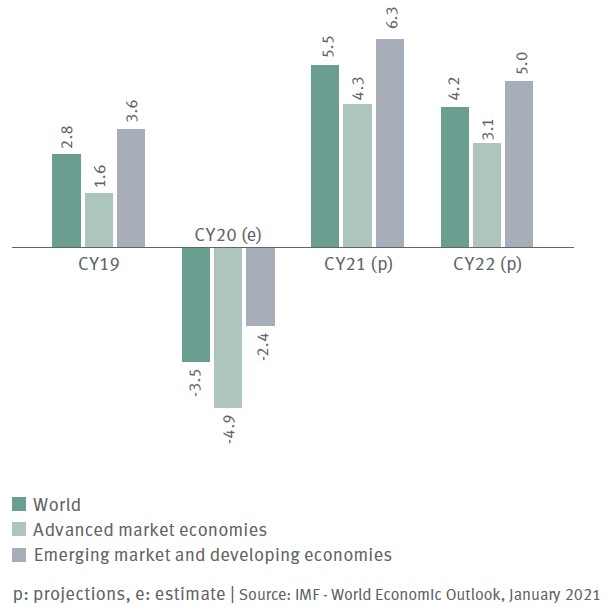
Outlook
Recovery in global growth will largely be a function of how countries contain the pandemic and bounce back from its negative impact. Several countries have approved vaccines and are distributing them in a phased manner. Access to medical interventions, effectiveness of monetary policy support, exposure to cross-country spillovers are prominent factors driving the recovery. Thus the pace of recovery will vary. Coordinated effort is required by key economies to bring the pandemic under control. Ensuring access to vaccines at affordable rates and adequate liquidity to weaker economies is the need of the hour.
In this scenario, global economic growth is expected to touch 5.5% in 2021 and 4.2% in 2022. This is 0.3 percentage points higher than the IMF's earlier forecast made in October 2020. It reflects expectations of a vaccine-powered strengthening of economic activity later in the year and additional policy support in a few large economies. Emergence of renewed waves and new variants of the virus are key risks to economic recovery.
India
In FY21, India’s GDP is estimated to contract by 7.7% (Source: Economic Survey 2020-21) owing to the impact of the pandemic. Manufacturing and services segments are likely to decline by 9.6% and 8.8%, respectively. On the other hand, the agriculture segment is likely to grow comma after 3.4% providing some support to the economy. Signs of uptick were visible in the second half of the year due to consumption growth. However, recovery to prepandemic levels will take some time. Inflation remained above the Reserve Bank of India's (RBI) comfort levels for a large part of the year. The government has made significant expenditure to protect the lives of the country’s citizens as well as to revive the economy. Following the twin pressures of COVID-19 and spending support need to encourage economic recovery, fiscal deficit for FY20 is estimated to touch a high of 9.5%.
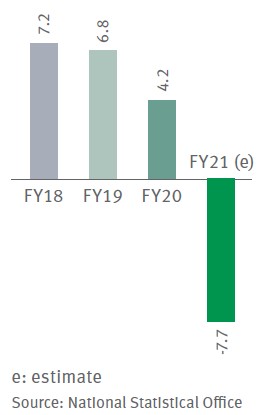

Outlook
With the world’s largest vaccination drive currently underway in India, there is hope that the pandemic will be brought under control. Several indicators such as power demand, rail freight, e-way bills, GST collection, steel consumption, among others are trending positively and could lead economic recovery. FY22 is likely to be a better year with growth coming back gradually. The IMF estimates India’s GDP to grow 11.5% in FY22 and 6.8% in FY23. A combination of monetary and fiscal reforms, lower oil prices and improving health of corporates could drive this recovery.
Measures such as lower corporate taxes for new manufacturing units will be key to making India a preferred manufacturing destination in Asia. A large domestic market, improving ease of doing business, reasonable labour costs and availability of skilled resources are other enablers for such a shift. Thus India’s manufacturing sector could witness sustainable recovery, going forward. With most companies coming to terms with the Insolvency and Bankruptcy Code, 2016 (IBC) due to takeover by larger, more capable corporates, private capex is likely to get a boost over the medium term.

Automotive sector review
The slowdown in automotive sales witnessed through the year 2019 was aggravated sharply by the spread of the pandemic during the year 2020. While the impact was felt by all segments (see table), Commercial Vehicles (CVs) were particularly hit due to the slowing economic activity. Agriculture tractors performed much better than other segments as the agriculture sector was largely unaffected by the lockdown.
In December 2020, sales of Passenger Vehicles (PVs) and two-wheelers witnessed a resurgence of growth. Release of pent-up demand, the festive season and rising focus on maintaining social distancing (by travelling in personal vehicles) were key drivers of this improvement. Exports proved to be the saviour for the industry during the immediate post-lockdown period.
Auto sales

The Government of India announced some measures to provide relief to the sector over the medium to longer term.
Outlook
Year 2020 witnessed a significant postponement of replacement demand for PVs. As the economy gathers pace, this demand could start trickling in during 2021. Vehicle scrappage policy could also aid demand for new vehicles, along with continuous innovations and new launches. With the need for personal mobility growing, the number of first-time buyers is likely to be high, aiding growth of compact cars.
Over the medium to long term, structural factors such as growing congestion in bigger cities, growth of ride-hailing apps such as Ola and Uber, moderating economic growth and subdued consumption will influence automobile sales. Amid strengthening infrastructure and favourable policies for Electric Vehicles (EVs), more users are likely to adopt EVs (starting with public transport vehicles). This is another key growth avenue for the automotive sector.
On the other hand, favourable interest rates, growth in rural areas and underpenetration of PVs could propel growth of vehicles.

Industrial sector review
Industrial activity in India came to a standstill after the imposition of the six-week nation-wide lockdown starting in the second week of March 2020. The Index of Industrial Production (IIP) fell 18.3% in the month of March and by a massive 56.3% in April. However, as the economy started opening up in late May, this metric has consistently improved. Overall IIP declined 15.8% in June and 1.9% in November. Output of core sectors such as cement, steel, coal and electricity generation have been witnessing a gradual uptick. As the economic recovery firms up, these indicators will also improve, aiding the prospects of allied sectors.
Outlook
Despite significant unplanned expenditure since the outbreak of COVID-19, the government plans to continue investing in the areas of health, manufacturing, and infrastructure to help boost recovery. It plans to increase allocation to key schemes, promote foreign participation and continue with a reforms-oriented approach. Large projects such as development of industrial corridors, smart cities, and initiatives such as Atmanirbhar Bharat and ‘Make in India’, among others, are likely to aid the performance of the industrial sector over the next few years. Additionally, a host of measures are underway to strengthen India's railway infrastructure. This includes upgradation of railway stations, building and expanding Metro stations and replacing older coaches. All these measures are expected to impact favourably on the growth prospects of our industrial business.

Schaeffler India: SCOT analysis
The global pandemic has caused major disruptions in business operations and livelihoods. We formulated a comprehensive Business Continuity Plan after considering the necessities of our stakeholders and revamped our processes in order to revitalise our business activities.
Management during the pandemic
There was an expeditious need for the business to shift to completely digital systems in order to manage affairs. Business meetings were held on various virtual platforms available. We shifted our focus on utilising digital marketing automation and opted for digital closings with regard to the transactions.
Ensuring the well-being and safety of our employees, we initiated and expanded flexible work arrangements with sufficient infrastructure to work remotely and safely.
Steps taken during the pandemic
Total contribution to community
initiatives during COVID-19 pandemic
Community care
Contribution to PM Cares Fund
Post-lockdown measures
Continuous communication with our staff, customers and supply chain partners enabled us to establish trust, visibility and proactivity across all junctures. Constant and transparent communication that generated value, help and support during any business change and disruption helped us gain the trust of our stakeholders.
Safety measures at our plants
Our plant’s CMT teams ensured a controlled shutdown of the respective sites and their subsequent re-activation. Site security, medical and maintenance staff were available throughout the period and we established a mechanism for employee traceability within the plant premises through their organisation into groups (from entry to exit). We also created SOP for re-activation of plants in complete alignment with Group EHS, national directives issued by the government and customer best practices.
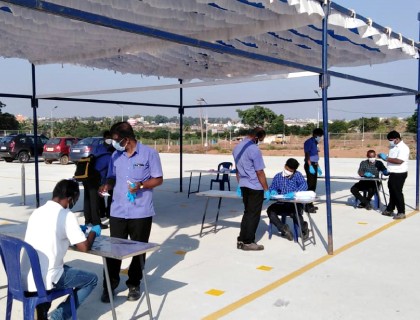

Our performance in Q1 and Q2 of the reporting year was adversely impacted by the pandemic. However, our response to the crisis was agile across the operating canvas. Our robust safety measures, stringent cost discipline, realisations from new projects, balanced portfolio management between industrial and automotive segments and a favourable demand scenario on the back of economic recovery helped us tide over the crisis. We improved our performance significantly in the following quarters. Our intelligent and agile capacity utilisation also helped us improve our performance. On the revenue front, our Q4 performance was one of the best of that in the preceding eight quarters.
Automotive
Our long-standing relationship with automotive OEM manufacturers helped us significantly during the year. On the aftermarket and distribution front, cost rationalisation, adopted last year, had a positive impact on our bottom-line performance. In 2020, we also managed business growth in our commercial vehicle segment, with the completion of multiple projects that were in the pipeline. While the automotive sector is still transitioning from BS-IV to BS-VI, we have already expanded our presence in the gasoline engines segment to minimise our risk exposure. This helped us gain considerable mileage with the country’s top 5 automotive manufacturers across the chassis, engines and transmission segments. We launched a comprehensive range of lubricants for all vehicle segments under the brand name ‘Schaeffler TruPower’. We have received very positive response from the market to this product range with a strong order book. With the gradual unlocking of the economy, and multiple initiatives undertaken by the government to propel the economy, our automotive business is likely to see faster growth, going forward.
Industrial
This segment contributes 42% to the entire business. Tepid growth in the country’s industrial sector adversely impacted the performance of this business in the initial quarters of the fiscal year. However, we continued to focus on operational efficiency and stringent cost efficiency to retain our competitive edge. Our strong legacy of innovation also helped us create differentiated products to gain market traction. We launched industry-leading products (OPTIME and Quick Centre) with unique value propositions, and they are receiving positive response from customers. This business segment registered good growth in the Q4 and is likely to grow faster in the coming quarters.
2020 saw a degrowth of close to 14% in our net revenues. During the year, our net revenues stood at ` 37,618.4 million compared to ` 43,606.3 million in 2019. Our well-balanced portfolio, deep customer connect and stringent cost discipline helped minimise significant impact on the bottom-line. However, high input costs remained a concern throughout the year. Our bottom-line performance gradually recovered across the quarters. We generated a strong cash flow in Q4, which was 66.5% higher than that in Q3 of 2020 and 18.6% higher than that in Q4 of 2019. Notwithstanding challenges, we managed a 14.4% EBIDTA margin, a marginal decline from last year’s 14.8%. This happened against the backdrop of the recovery from the automotive sector, followed by some of the sectors in the broad industrial landscape, as well as our own intelligent and agile utilisation of available capacity. Our exports sales remained more or less the same as in 2019.
Revenue mix: 2020
(%)
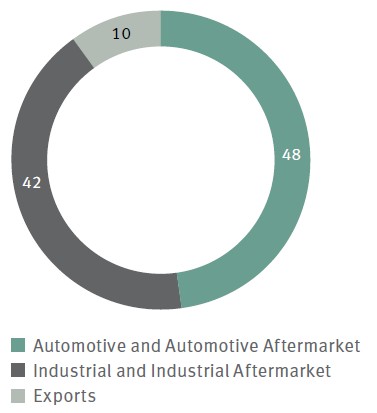
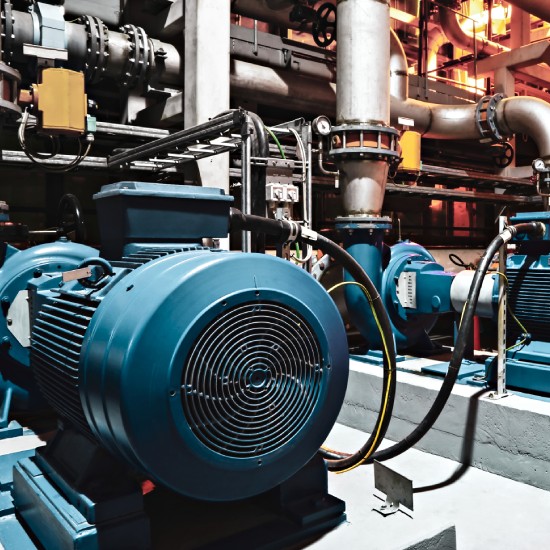
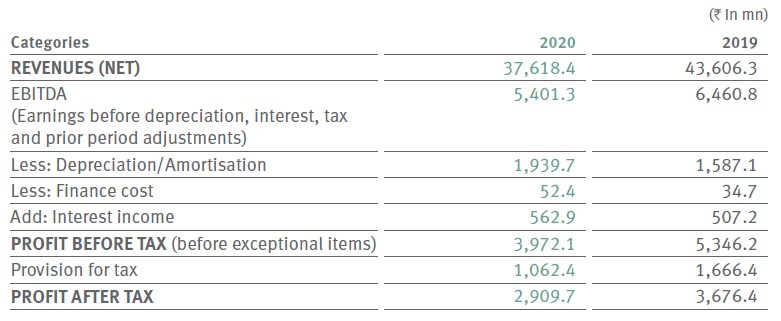
Revenue

Gross Operating Profit (EBITDA)

Depreciation

Profit before tax

Taxes

Profit/(Loss) after tax

Cashflow

*Earnings before Interest, Tax, Depreciation and Amortisation
**Figures are net
Revenue mix: 2020
(%)
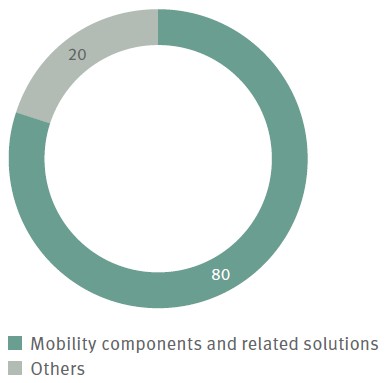

Schaeffler India is progressing well on most of its strategic objectives outlined in this report and will continue to make requisite investments to take the Company’s growth to the next level. The pent-up demand in the market, our counter measures, successful realisation of projects in the pipeline and a balanced portfolio management between automotive and industrial have helped us build a strong order book and deepen the existing connect with our customers. Our range of lubricants has received tremendous response in the marketplace and the demand uptick in industrial sectors such as wind, the distribution aftermarket, the off-road sector and the two-wheelers segment helped us remain optimistic throughout the year.
From the parent and promoter side, there is complete attention on India and this is reflecting well on our localisation strategy. We are looking to strengthen our local R&D capabilities and expand its edge to the maximum as India gradually becomes the export hub for all the products we supply to the Asia-Pacific region.
Going forward, in the automotive business, we will continue to focus on providing innovative products and solutions driven by superior technology. Our industrial business will continue to enhance our wallet share with existing relationships and help us add new clients across the value chain.
Paralleling the risk management system, Schaeffler India has a system of internal controls over financial reporting (IFC) ensuring the accuracy of the accounting system and the related financial reporting. The internal control system provides for well-documented policies and procedures that are aligned with Schaeffler Group standards and processes. It adheres to local statutory requirements for orderly and efficient conduct of business, safeguarding of assets, the detection and prevention of frauds and errors, adequacy and completeness of accounting records and timely preparation of reliable financial information. The efficacy of the internal checks and control systems are validated by internal auditors.
Our IFC is conceptually based on the regulatory framework, as applicable. The controls defined in the framework are applied at all levels – entity level, process level and IT systems level.
At each year-end, management assesses the appropriateness and effectiveness of the IFC in place. To this end, we use a standardised methodology to identify the processes relevant to IFC, define the required controls and document them in accordance with uniform requirements. This is then followed up with a review of the defined controls that is performed using a risk-based approach. The process controls are self-evaluated and are audited by the internal and statutory auditors. Wherever control weaknesses exist, actions to eliminate them are defined and monitored regularly to overcome.
Cautionary statement
Statement made in the Management Discussion and Analysis describing the Company’s objectives, projections, estimates, expectations may be “forward looking statements” within the meaning of applicable securities laws and regulations. Actual results could differ from those expressed or implied. Important factors that could make a difference to the Company’s operations include economic conditions affecting demand supply and price conditions in the domestic and overseas markets in which the Company operates, changes in the government regulations, tax laws, other statutes and other incidental factors.